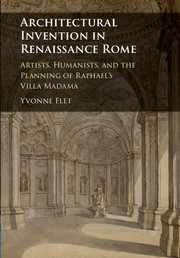 Architectural Invention in Renaissance Rome
Architectural Invention in Renaissance Rome Book contents
- Frontmatter
- Dedication
- Contents
- List of Plates
- List of Figures
- Preface and Acknowledgments
- Note on Translations and Abbreviations
- Introduction: The Nature of Invention, in Word and Image
- 1 Reviving the Corpse
- 2 Writing Architecture
- 3 Sperulo's Vision
- 4 Encomia of the Unbuilt
- 5 Metastructures of Word and Image
- 6 Dynamic Design
- Conclusion: Building With Mortar and Verse
- APPENDIX I Francesco Sperulo, Villa Iulia Medica versibus fabricata/ The Villa Giulia Medicea Constructed in Verse: critical edition and translation by Nicoletta Marcelli and gloss by the Author
- APPENDIX II Francesco Sperulo, Villa Iulia Medica versibus fabricata: Analysis of the presentation manuscript
- APPENDIX III Francesco Sperulo, Ad Leonem X de sua clementia elegia xviiii
- Notes
- Bibliography
- Index
Introduction: The Nature of Invention, in Word and Image
Published online by Cambridge University Press: 06 January 2018
- Frontmatter
- Dedication
- Contents
- List of Plates
- List of Figures
- Preface and Acknowledgments
- Note on Translations and Abbreviations
- Introduction: The Nature of Invention, in Word and Image
- 1 Reviving the Corpse
- 2 Writing Architecture
- 3 Sperulo's Vision
- 4 Encomia of the Unbuilt
- 5 Metastructures of Word and Image
- 6 Dynamic Design
- Conclusion: Building With Mortar and Verse
- APPENDIX I Francesco Sperulo, Villa Iulia Medica versibus fabricata/ The Villa Giulia Medicea Constructed in Verse: critical edition and translation by Nicoletta Marcelli and gloss by the Author
- APPENDIX II Francesco Sperulo, Villa Iulia Medica versibus fabricata: Analysis of the presentation manuscript
- APPENDIX III Francesco Sperulo, Ad Leonem X de sua clementia elegia xviiii
- Notes
- Bibliography
- Index
Summary
What extraordinary new mansion is this, rising so swiftly? To what end is there so much labor and sweat all around? Everywhere crowds of febrile workers, iron tools in hand, fall upon the stones. Vast foundations are laid in the open ground, from which an enormous mountain-peak of roofline climbs toward the stars. The clangor from the arduous work wanders through the seven hills of marveling Rome, the winding valleys echoing with the sound.
Francesco Sperulo, The Villa Giulia Medicea Constructed in Verse (Villa Iulia Medica versibus fabricata), 1–7.In early 1519, the humanist and papal courtier Francesco Sperulo went for a walk on the Monte Mario, a wooded hill on the northwest edge of Rome with a breathtaking view of the city (Plate I). There, he tells us, he was inspired to write a poem, which he did as soon as he returned home. The object of his visit and his verse was the construction of the magnificent new villa overlooking the Tiber that we now know as Villa Madama, then being built by Pope Leo X Medici and his cousin and vice chancellor of the church, Cardinal Giulio de’ Medici. Not only a pleasurable villa suburbana for the Medici, this complex would also be a papal hospitium to welcome foreign dignitaries about to make a ceremonial entry into Rome. It was to be one of the first grand villas of the Roman Renaissance, conceived on a colossal scale unprecedented in modern Rome. The complex was also intended to rival and surpass its ancient prototypes, known from archeological remains as well as evocative literary descriptions of Roman villa life. The new villa, designed and decorated by Raphael and his associates, would present a Rome of revived ancient splendor and power to its important visitors. For Raphael, at the height of his powers, the Medici villa commission was a rare opportunity to conceive architecture and decoration together from the ground up, and a unique chance to design an entirely new, freestanding building and its landscape. As it turned out, it was also his last testament, incomplete at the artist's death in 1520. Although the utopian complex was only partially realized, one wing and some of the gardens were largely completed and lavishly ornamented, creating a novel and extraordinary decorative ensemble integrating landscape, architecture, ancient sculpture, painted and stucco decoration, gardens, and waterworks (Plates II–VIII).
- Type
- Chapter
- Information
- Architectural Invention in Renaissance RomeArtists, Humanists, and the Planning of Raphael's Villa Madama, pp. 1 - 14Publisher: Cambridge University PressPrint publication year: 2018


